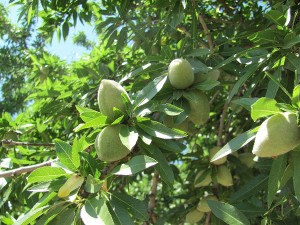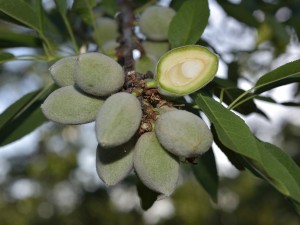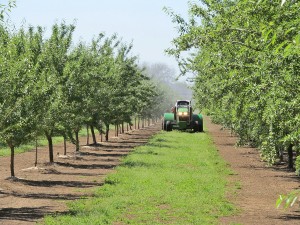
Director, Member Relations
Northern Region –
April was a warm month overall, with weather was more typical of late spring and early summer. Low temperatures averaged in the 40s to low 50s and highs averaged between 70 and 80 degrees, with a few days reaching the low 90s. Isolated thunderstorms roamed over the region during the first week of the period, soaking some areas with up to 1.5 inches of rain. Growers that received the greatest amount of rainfall were able to postpone irrigations, thereby saving some water for later in the season.
 Observers are reporting that the crop is developing well at this point in time, with few problems evident. Growers have largely been able to meet their orchards’ water needs, but are concerned about the requirements that must be met later in the season. Although things look positive at the moment, water continues to be the main topic of conversation across the Northern Region. Surface water is in short supply, with growers receiving anywhere from 0 to 75% of their normal water allocation. With short supplies of surface water, growers will have to rely on pumping groundwater to carry their crop through harvest. Another year of increased pumping leaves many hoping that they can maintain the integrity of their wells. Currently, wells are holding strong and growers are able to give their crop the water and nutrients that they need to sustain their crop.
Observers are reporting that the crop is developing well at this point in time, with few problems evident. Growers have largely been able to meet their orchards’ water needs, but are concerned about the requirements that must be met later in the season. Although things look positive at the moment, water continues to be the main topic of conversation across the Northern Region. Surface water is in short supply, with growers receiving anywhere from 0 to 75% of their normal water allocation. With short supplies of surface water, growers will have to rely on pumping groundwater to carry their crop through harvest. Another year of increased pumping leaves many hoping that they can maintain the integrity of their wells. Currently, wells are holding strong and growers are able to give their crop the water and nutrients that they need to sustain their crop.
Growers continue to mow their orchard floors and are monitoring for pests and diseases. Some growers have applied fungicides to prevent disease in the coming summer months. Isolated insecticide applications have also been conducted to combat the Leaf-Footed Plant Bug, a potentially serious pest.
Central Region –
April provided growers with favorable conditions, with summer-like weather consistent throughout the Central Region. Average low temperatures for the month were in the mid 40s, with high temperatures in the mid 70s with temperatures reaching the mid to upper 80s the last week of April. A series of thunderstorms passed through the Central Region in early April, dropping anywhere between .25” and .75” of rain. These storms also generated impressive amounts of hail along the eastern foothills, while damage was limited to just a few orchards. However, while limited in scope, the affect orchards suffered significant damage.
The crop has developed at a brisk pace. Growers have noted that the crop is sizing well, although some are expressing concern about the hulls being larger than normal. Growers have become slightly more optimistic of their Nonpareil crop, although most agree that it is lighter than 2014. Pollenizer varieties are typically carrying better crop loads than the Nonpareil. However, observers are reporting a large degree of variation from orchard to orchard.
Water districts throughout the Central Region are delivering between 0 and 30 inches of water to growers this growing season. The shortage of district water will impact all growers, as they rely more heavily on their agriculture wells, and others scramble to purchase water from neighbors with access to well water. As growers rely more heavily on groundwater, they are keeping a close eye on the strength of their wells. Isolated instances of well failure have been reported, with most wells appearing to be strong for the time being.
Growers have been observed fertilizing, irrigating and mowing between the tree rows. Some growers that use flood irrigation have pulled furrows or ridges, opting to irrigate smaller sections of their orchard and more accurately target the flow of water.
Southern Region –
Temperatures in the southern San Joaquin Valley were starting to rise at the end of the period, with highs at or slightly above 90 degrees, ahead of the usual warming pattern. For most of the month daily highs hovered between the low 70s and mid 80s with lows ranging from the low 40s to mid 50s. As in the Central Region, a series of storms delivered from .25” to just under an inch of rainfall to the northern areas of the region during the first days of April, with hail causing significant damage to the crop in several orchards in the Chowchilla of Madera County.
 Nuts are continuing to develop well ahead of historical norms. Kernels of the Nonpareil variety are approximately one-half solidified with other varieties not far behind. Observers are reporting a wide degree of variation in the apparent crop set, with some plantings displaying very good crop potential and others notably lacking. Inconsistencies have also been observed from tree to tree within the same orchard. Observers have noted very few broken limbs in orchards as nuts continue to gain weight, a typical observation on a lighter crop year.
Nuts are continuing to develop well ahead of historical norms. Kernels of the Nonpareil variety are approximately one-half solidified with other varieties not far behind. Observers are reporting a wide degree of variation in the apparent crop set, with some plantings displaying very good crop potential and others notably lacking. Inconsistencies have also been observed from tree to tree within the same orchard. Observers have noted very few broken limbs in orchards as nuts continue to gain weight, a typical observation on a lighter crop year.
Water continues to be a major concern in the Southern Region. Some trees are already showing signs of salt burn from the application of salty ground water. With supplies of surface water from local irrigation districts scarce, growers are being forced to rely more heavily upon their wells. And, observers have noted that output from wells is steadily decreasing. To date growers have managed to keep up with the orchard’s water needs. However, the summer months ahead will increase moisture demand and the potential for stress on the crop.
Some treatments to control expanding populations of web-spinning mites have been reported, along with treatments to control Leaf-Footed Plant Bug. Herbicide applications continue as growers are trying to keep orchard floors as clean as possible in order to save water. Fertilizers continued to be applied as needed to sustain this year’s crop and to help develop the flower buds need for next year.